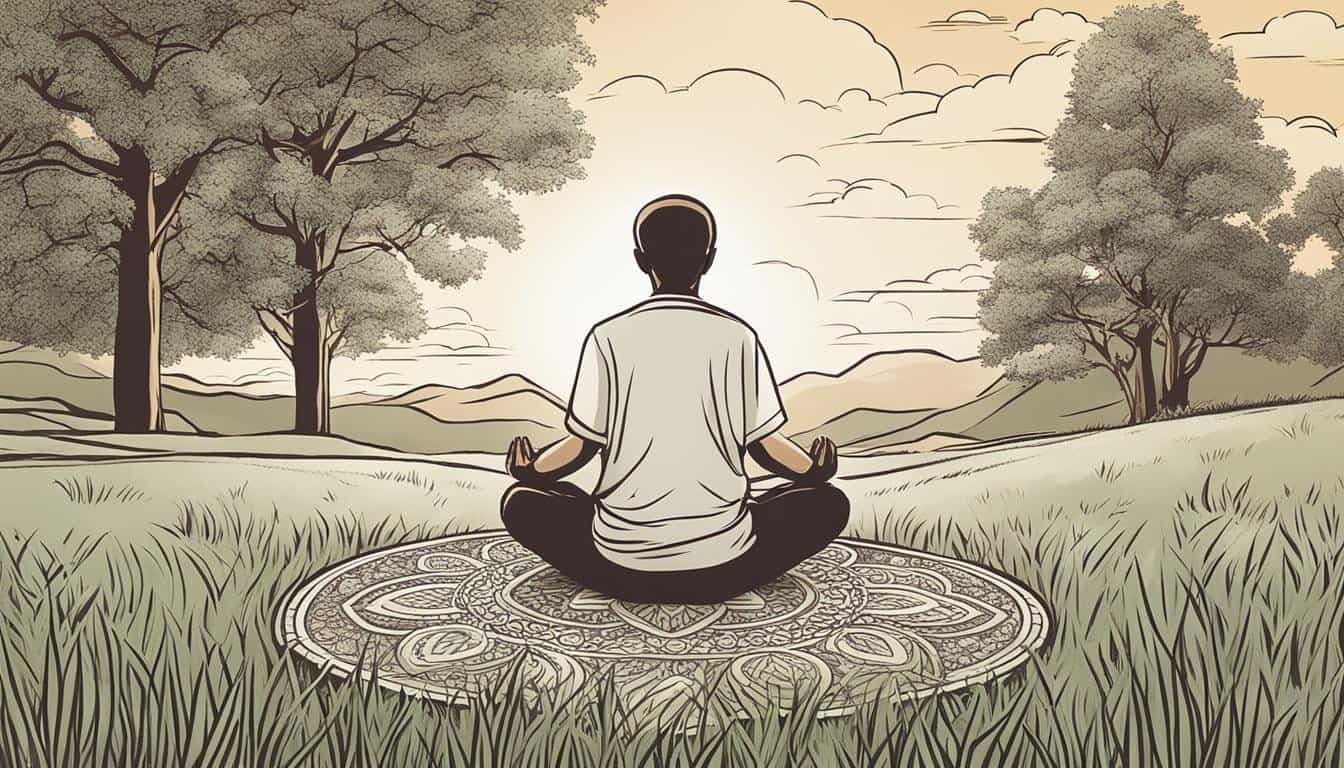Unveil Inner Harmony Techniques for Serenity
“The purpose of life is not to be happy. It is to be useful, honorable, and compassionate. It’s about making a difference with a life well-lived.” – Ralph Waldo Emerson
Inner peace is key to a happy, harmonious life. It brings tranquility and balance. This allows us to gracefully handle life’s challenges.
This article shows ways to achieve inner harmony. We look at self-care, mindfulness, stress management, emotional balance, holistic wellness, and personal growth. These methods empower us to find inner peace and live fully.
Key Takeaways:
- Inner peace is a state of tranquility and balance that allows individuals to navigate through life with grace and serenity.
- Various techniques such as self-care practices, mindfulness exercises, stress management tools, emotional balance strategies, holistic wellness methods, and personal growth techniques can help cultivate inner peace.
- Attaining inner peace brings numerous benefits including reduced stress and anxiety, improved mental and physical health, increased self-awareness and self-acceptance, greater clarity and focus, improved relationships, and increased creativity and productivity.
- Embarking on the journey to find inner peace requires patience, persistence, and effort, but the rewards are well worth it.
- By incorporating these inner harmony techniques into our lives, we can experience a more serene and balanced existence.
Embrace Simplicity for Inner Harmony
Creating a simple living space can bring inner peace. Our world is full of distractions and too much stuff. Choosing a minimalist life helps us find quiet and calm.
Minimalist living means focusing on what’s important. It’s about keeping what matters and letting go of the rest. This makes our lives clear and peaceful.
Embrace simplicity by eliminating the unnecessary. Keep things that make you happy and have a purpose. Say goodbye to clutter that takes away your peace.
“Simplicity is the ultimate sophistication.” – Leonardo da Vinci
Peaceful living isn’t just about your space. It’s also about simple habits and routines. This helps reduce stress and makes us happier.
Minimalist Living Tips:
- Get rid of things you don’t need or love.
- Arrange your stuff simply and usefully.
- Think carefully before buying new things.
- Choose quality over quantity in what you buy.
- Make special places for rest and recharge.
Embracing simplicity is a continuous process. Keep checking your things and choices to match your values and inner peace.
Letting go of extras and living a simple life can make your space peaceful. It nurtures your well-being, letting your true self shine.
Find Solitude and Social Connections
Finding peace within ourselves is a journey. It needs both quiet moments and time with others. When alone, we look inward and understand our thoughts and feelings. This self-reflection helps us grow personally.
Time by ourselves lets us step back from everyday stress. It gives us a chance to recharge and find our joy. Doing things we love alone can make us feel peaceful and happy.
Yet, peace also comes from being with others. Good friendships and bonds make life richer. Sharing laughs and stories with people adds to our sense of togetherness.
Be it chatting with a friend or doing things in a group, these moments matter. They give us a sense of support and belonging. Making memories with our dear ones fills our lives with joy.
“Solitude and social connections act as two sides of the same coin on the journey to inner peace. We need moments of introspection to truly understand ourselves, while the support and connection from our loved ones enriches our lives.”
It’s important to find a good mix of solitude and socializing. This balance helps us find peace. It lets us know ourselves better, build strong relationships, and enjoy life.
Benefits of Finding Solitude and Social Connections
- Fosters self-reflection and personal growth
- Recharges and rejuvenates the mind and body
- Enhances self-awareness and understanding
- Strengthens bonds and relationships
- Creates a sense of belonging and support
Harness the Power of Self-Reflection and Writing
Self-reflection can start you on a path of personal growth and peace. Writing your thoughts, feelings, and life events is powerful. This way, you look inside yourself and learn more.
Self-reflection through writing gives you insights. You learn about your beliefs, values, and dreams. Reflecting and writing down your journey helps you see your growth.
Journaling turns abstract ideas into something real. Writing helps you see patterns and areas to improve. You can use a diary, gratitude journal, or free thoughts. This process helps you explore your deepest self.
Writing lets you express feelings and handle tough times. It’s a safe place for you to share your thoughts. It also lets you be creative and try different writing styles.
By using self-reflection and writing, you learn more about yourself. This journey improves your inner self and overall happiness. You’ll better understand yourself and find peace.
Discover the Joy of Journaling
Journaling is a great way to reflect and write. It captures moments and helps with self-improvement. Journaling can guide you to set goals and celebrate your wins.
Journaling gives you a place to express without judgment. It’s private, so you can share your feelings and goals. Keeping a journal shows its positive effects on your well-being.
- 📓 Set aside time each day or week for journaling.
- 📓 Find a quiet space to reflect without distractions.
- 📓 Choose a journal or notebook that feels right for you.
- 📓 Try different journaling styles, like free writing or lists.
- 📓 Write about things that matter to you, like goals or self-care.
- 📓 Be true in your writing, expressing your thoughts and feelings.
- 📓 See journaling as a way to care for yourself.
Remember, your journaling journey is yours alone. There’s no wrong way to do it. Try different methods, be yourself, and see your journal as a friend in self-discovery.
Create a Serene Physical Environment
The physical environment is key for inner peace. By choosing minimalist living spaces and serene places, we support our quest for tranquility.
Minimalist spaces bring calm and clarity. We choose items that spark joy and remove the rest. This helps eliminate distractions and lets our minds grow.
“A minimalist space is not just about aesthetics; it’s about creating an environment that promotes serenity and fosters a sense of peace within.”
Imagine a bedroom with clean, uncluttered surfaces. You feel calm as soon as you wake up. Now, picture a living area that’s simple and spacious. Your mind feels free here.
By living simply, we make places that calm us. These places match our simplicity desire.
Serene places also boost our well-being. Time spent by the beach or in a forest connects us with nature’s calm.
Picture relaxing on a quiet beach. You hear waves and feel the sand. Or think of walking in a peaceful forest, sunlight coming through the trees.
By seeking serene places, we find peace. These moments in nature let us reflect and escape life’s noise.
Our selection of environment is crucial for peace. Through simplicity and nature, we find a peaceful backdrop for our thoughts. Let’s build simple spaces and explore serene places. They lead us to inner harmony.
Breathe for Balance and Serenity
Our breath is a powerful tool for finding balance and serenity. Breathing techniques like the 4-6-8 pattern and Valsalva reflex can help achieve calmness. They are easy to do, yet very effective.
“Breathing is the key that unlocks the whole catalog of advanced meditation techniques.” – Sharon Salzberg
The 4-6-8 technique is simple. You inhale deeply through your nose for four counts, hold it for six, and exhale slowly through your mouth for eight counts. This breathing rhythm activates the body’s relaxation response. It reduces stress and brings calm.
The Valsalva reflex adds to inner peace. You softly press on your closed airway, like holding your breath with your mouth closed and nose pinched. This action stimulates the vagus nerve. It triggers the body’s relaxation, bringing tranquility.
Nose breathing is also beneficial. Breathing through the nose involves the diaphragm and slows our breathing rate. This technique calms the mind, lessens anxiety, and boosts well-being.
Then, there’s oceanic breathing or deep belly breathing. Take slow, deep breaths, letting the belly rise and fall. This activates the parasympathetic nervous system. It enhances relaxation and tranquility in the body.
Bring Balance to Your Life
Using techniques like 4-6-8 breathing, Valsalva reflex, nose breathing, and oceanic breathing can help. Incorporate them into your daily routine for balance and serenity. Take a moment each day to connect with your breath. Let it guide you to peace and tranquility.
Practice Mindfulness for Inner Peace
Practicing mindfulness is a key way to find inner peace. It lets us live in the moment. This enhances self-awareness and emotion management. By observing our thoughts and feelings without judgment, we achieve balance.
“Mindfulness is the key to unlocking inner peace. It is the practice of bringing our full attention to the present moment, without judgment or attachment.”
Mindfulness means paying full attention to our thoughts, emotions, and sensations. This awareness helps us realize our mind’s patterns. Self-awareness helps us understand our feelings and react healthily.
Mindfulness brings our focus to the present, away from past or future worries. We learn to engage fully with our surroundings and ourselves. This lets us enjoy each moment and find happiness in the simple things.
We can practice mindfulness daily through meditation, breathing exercises, and mindful eating. These practices enhance our presence and self-awareness. They bring us closer to our inner peace.
- Start your day with a mindfulness meditation: Each morning, quietly focus on your breath for a few minutes. Experience each breath fully, ignoring distractions. This sets a peaceful tone for your day.
- Practice mindful breathing when stressed: If overwhelmed, concentrate on your breath. Take slow, deep breaths and notice how they feel. This can calm you and bring you back to the moment.
- Engage in daily activities mindfully: Pay full attention to simple tasks, like eating or walking. Notice all the sensations and sounds. By enjoying each moment, we find peace in everyday life.
Mindfulness is a journey that requires time and consistent practice. Staying present and non-judgmental eventually becomes second nature. Persist, and it will lead to deeper peace and well-being.
The Benefits of Mindfulness:
- Enhanced self-awareness
- Improved emotional regulation
- Reduced stress and anxiety
- Greater focus and attention
- Increased compassion and empathy
- Improved overall well-being
Take a moment to pause and breathe. Connect with now. Mindfulness opens the door to inner peace and fulfilling life.
Cultivate Gratitude for Contentment
To find inner peace, practice gratitude. This means focusing on the good in life and being thankful for what we have. This shifts our view from lacking to having plenty, which makes us happier and more satisfied.
Gratitude helps us see the good things in life. It could be the small happy moments, friendships, or what we’ve achieved. It lets us enjoy and be present in every moment, seeing beauty in everything.
With gratitude, we feel more positive and joyful. Even in tough times, it helps us find moments of happiness. This lifts our spirits and makes us feel good.
Focus on the Positive
To grow gratitude, focus on what’s good in your life. Don’t think about what you’re missing or problems. Look for the good things and celebrate them.
“Gratitude turns what we have into enough.”
By seeing the positive, we notice the plenty around us. We see small wins, kind actions, and beautiful moments that are easy to miss.
Appreciation in Everyday Moments
Find gratitude in everyday things. This might be enjoying your coffee, feeling the wind, or laughing with friends. These small things fill our hearts with thankfulness.
“Gratitude can transform common days into thanksgivings, turn routine jobs into joy, and change ordinary opportunities into blessings.”
A Ripple Effect of Satisfaction
Gratitude brings joy and also makes us healthier. It makes us focus less on what we don’t have. This can make us less stressed, more resilient, and improve how we get along with others.
Being thankful reminds us of the good we have. It makes us happier and brings peace inside us.
Prioritize Self-Care for Inner Well-being
Making self-care a priority is key to inner well-being and peace. Caring for yourself physically, emotionally, and mentally leads to a balanced life.
1. Get Enough Sleep
Sleep is crucial for good health. It lets your body and mind heal and refresh. Strive for 7-9 hours of sleep nightly for balance and wellness.
2. Eat Healthily
Adopting healthy eating habits is important. Eat a variety of fruits, vegetables, proteins, grains, and fats. Choose fresh, whole foods for energy and health.
3. Engage in Regular Exercise
Exercise improves both your body and your mood. It releases endorphins, cuts stress, and lifts your spirits. Find activities you love like walking, yoga, or swimming, and stick with them.
4. Indulge in Joyful Activities
Find time for things that make you happy. It could be a hobby, family time, music, or art. Adding joy to your days feeds your soul and brings peace.
“Taking care of yourself is not selfish—it’s essential. Self-care is giving the world the best of you, instead of what’s left of you.” – unknown
Self-care is a must, not a luxury. Practices like adequate sleep, healthy eating, regular exercise, and joyful activities boost your well-being and peace.
Think about how to make self-care a part of your day. Start with small steps that reflect your values for a peaceful, fulfilling life.
Connect with Nature for Calmness
Finding calmness in our fast-paced world can be hard. But, nature can help ease the stress of daily life. Its beauty has a strong effect on us, giving us a break from our busy schedules.
When we spend time in nature, we enjoy its beautiful landscapes and calming sounds. The sound of leaves rustling, birds chirping, and rivers flowing soothes our mind.
Activities like hiking, cycling, or walking help us connect with nature. Being in the greenery or sunlight helps our worries fade away. We feel peaceful and calm.
“In every walk with nature, one receives far more than he seeks.”
– John Muir
Seeking quiet places in nature allows us to think and reflect. Surrounded by trees, meadows, or mountains, we find peace. In silence, we understand ourselves better.
Weekends in a cabin, camping under stars, or picnics in the park refresh us. Nature brings a calmness that’s unique.
Benefits of Connecting with Nature:
- Reduces stress and anxiety levels
- Enhances mood and overall well-being
- Boosts creativity and focus
- Improves physical health and vitality
- Promotes a sense of gratitude and appreciation
Nature doesn’t always mean grand adventures. Small moments, like being in a park, gardening, or star-gazing, impact our peace.
Let nature lead you to calmness. Go outside, breathe fresh air, and let nature’s beauty surround you. Enjoy the peace and reconnect with the natural world.
Embrace the Journey and Persistence
Finding inner peace takes time. It’s a journey of learning about yourself. This journey requires patience, persistence, and effort. You’ll face many highs and lows. But it’s through these experiences that you grow. Eventually, you find a happier and more peaceful life.
At the heart of this journey is patience. It helps you stay calm during tough times. It teaches you to believe in yourself and your ability to get past hurdles. Patience is key because inner peace takes time to build.
Patience is not the ability to wait, but how you act while you’re waiting.
Persistence is equally important. It means keeping on even when things are hard. It’s about not giving up on finding peace, no matter what happens. Every time we face a setback, persistence helps us see it as a chance to grow.
Effort moves the journey forward. It means really putting yourself into finding peace. This comes from taking care of yourself, being mindful, and being thankful. By putting in the effort, we make room for peace in our lives.
Embracing the Journey with Inner Peace Exercises
Here are some exercises to try on this journey:
- Mindful breathing: Every day, take time to breathe deeply. This can help you feel centered and calm, even when things get busy.
- Journaling: Write about what you’re feeling and thinking. This helps clear your mind and helps you understand yourself better.
- Gratitude practice: Think of three things you’re grateful for each day. This shows you the good in your life and boosts your mood.
- Self-care rituals: Make self-care a priority. This includes sleeping well, eating right, exercising, and doing things you love.
Remember, everyone’s journey to inner peace is different. Be nice to yourself as you go. Celebrate your progress and learn from your experiences. With patience, persistence, and effort, you can live a life of balance and deep happiness.
Conclusion
Finding inner peace is a life-changing journey with many rewards. It helps reduce stress and make you healthier. Feeling calm inside makes you understand and love yourself more, which is key for growing as a person.
Inner peace also makes you see things clearer and handle problems better. It makes relationships stronger and interactions more positive. This leads to being more creative and getting more done, as a calm mind is more focused.
Practices like mindfulness, taking care of yourself, writing in a journal, and loving simple things can help find inner peace. Putting in the time and effort into these activities can make life more peaceful. You’ll feel happier, more satisfied, and have a strong sense of purpose.







